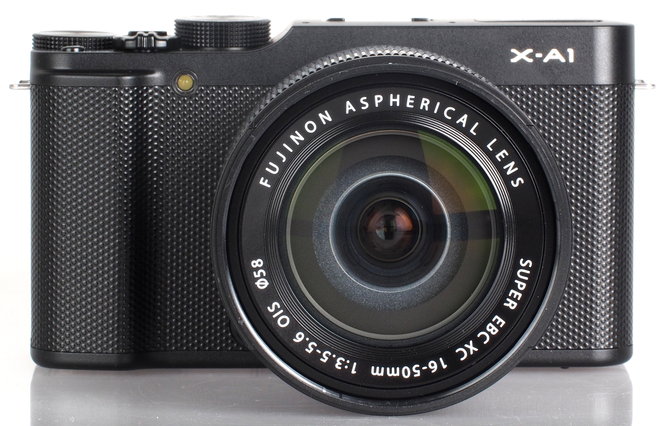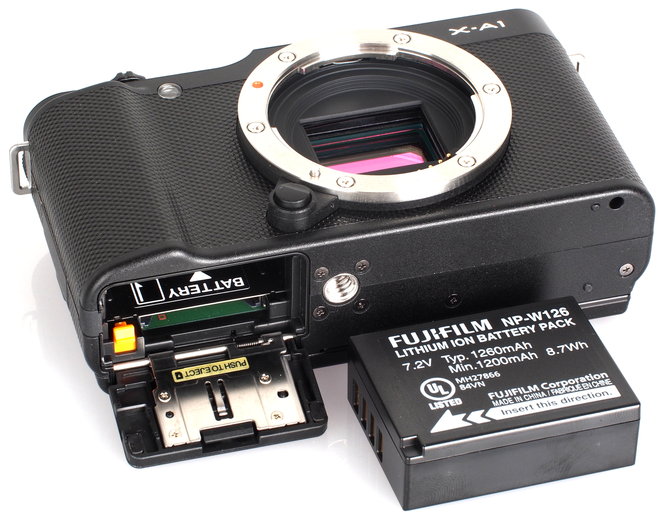It's the first model in Fujifilm's X-series to
bear an entry-level price-tag, but does the X-A1 stand up to its bigger
brothers?

Fujifilm X-A1 Review
The
Fujifilm X-A1 offers a way for those on a tighter budget to break into the
company's now legendarily popular X-series. The camera comes with a retail
price of £499, which offers a serious discount on popular stablemates
like the X-Pro1.
While the
X-A1 retains the 16MP CMOS sensor common to the Fujifilm X-series (though not
the advanced X-Trans version), the X-A1 ditches a viewfinder in favour of a tilting LCD screen, making it a rangefinder in
appearance only.
The
controls are positioned sensibly for one-handed operation. There's a customisable function button toward the front of the
top-plate as well as a button on the back that activates a handy menu for quick
adjustments to frequently used settings.
Manual
exposure control is achieved via a large round dial on the top-plate for
exposure settings, and a smaller recessed wheel above the thumb rest for
exposure compensation.
Unfortunately
the top-plate dial causes a slight handling issue - it's quite easy to jog
accidentally, resulting in a few over or under-exposed shots.

The Fujifilm X-A1's monitor is good but also
fairly conventional, with a 3in screen and a resolution of 920k dots
The X-A1's
monitor is good but conventional, being a 3in screen with 920k dots of
resolution that tilts 90° up and down but doesn't offer touchscreen
functionality. It's certainly sharp, and has an angle of view approaching 180°,
but it's very reflective and hard to use in bright sunlight. The frame rate is
also slow, with a distinct lag when panning.
A brisk
performer, the X-A1 is able to start up and take a picture in a little over two
seconds, and it shuts down again even quicker. Its shot-to-shot time in
single-shot mode is consistent at every zoom setting and in every shooting mode
at 1.1 seconds per shot, and it appears to be able to keep that pace
indefinitely.
One aspect
that's worth singling out is the high-ISO noise control, which is truly
exemplary. At up to ISO 3200, images are effectively noise-free, noise is just
barely visible at ISO 6400, and even at the extended settings of ISO 12,800 and
25,600, what noise there is looks exactly like film grain, with virtually no colour distortion. It's a truly impressive performance, and
one of the X-A1's main selling points.

Battery life is rated at 350 shots according to
Fujifilm / CIPA test results
Though we
were a little pressed to find a true weak spot, with the X-A1 it would be the
low-light focusing. Shooting in near darkness it does sometimes fail to focus
on some targets, though at least it always lets you know quickly. The camera
does have a focus-assist lamp, but this is positioned very close to the hand
grip so you'll have to be careful not to block it with your finger.
With a
16.3-megapixel sensor the X-A1 perhaps seems rather tame resolution-wise, but
the superb sharpness of the lens and the excellent image processing makes the
detail resolution appear much higher.
The X-A1 is
capable of producing sharp, high-contrast pictures and there's a growing line
of top-quality lenses to go with it.
Verdict
The
Fujifilm X-A1 is not only an excellent entry-level model for the X-series, it's
an outstanding camera in its own right, with the style, performance and
handling to appeal to ambitious casual photographers and budget- conscious
enthusiasts. Its superb high-ISO noise control makes it arguably the best CSC
in its price bracket.
Key specs ·
Sensor: 16.5MP APS-C CMOS ·
File formats: Raw, JPEG ·
Shutter speeds: 30-1/4000sec ·
ISO: 200-6400 (extendable to 25,600) ·
Exposure modes: PASM, Custom, Scene modes ·
Movie mode: Full HD 1920 x 1080, 30fps, stereo
audio ·
Display: 3in, 920k dots ·
Viewfinder: No ·
AF points: 49 ·
Built-in flash: Yes ·
Memory card: SD/SDHC/SDXC ·
Power: Rechargeable Li-ion battery ·
Dimensions: 116.9 x 66.5 x 39mm ·
Weight: 330g (including battery and memory
card) Best for ·
Those hankering after the retro looks and
sheer performance of the legendary X-Series ·
High ISO shooting as noise is rendered as
film-like grain Alternatives ·
Samsung NX300 $879.06 ·
Sony NEX-6 $1,326.88 ·
Fujifilm XE-1 $1,907.39 Pros ·
Stylish ·
Fast start-up and shooting speeds ·
Superior ISO noise control Cons ·
Low-light focusing slightly weak ·
Exposure compensation dial easy to knock ·
Reflective LCD
|